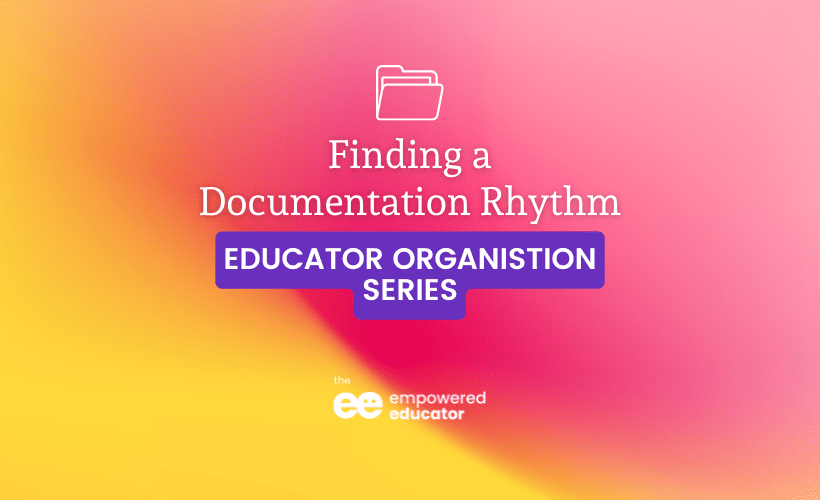
Organising educator paperwork and finding a workable rhythm can save a whole lot of time for early years educators when it comes to showing evidence of a documentation chain and the steps taken to support and extend a child's learning journey.
This is the first post in my new ‘Educator Organisation Series'. I'll be sharing some simple strategies, tips and tools to help educators take back control of their paperwork and documentation requirements. Whether you work in an early learning centre, provide home and family daycare or homeschool you will find information in this series to help you start taking action to become more organised and ditch the overwhelm!
To start us off let's talk about the dreaded planning & programming requirements. Hold it! Don't run away screaming.…I want to empower you to take control so you don't spend another year wondering how to get it all done without spending every weekend at your desk!
It's important to first identify what you are already doing that works or doesn't work. We then want to put a simple step by step plan of tasks in place that you can refer to as necessary to immediately know where you are up to, what you still need to do and the timeframe you have to get it done before paperwork stress begins to take over leaving you frustrated, resentful and confused about how to get everything done!
Organising Educator Paperwork – Are you doing too much or not enough?
What exactly are you keeping records of? Perhaps you are doubling up and don't even realise it as you have kept adding a template here, a new observation form there, a folder of photos on your computer, a folder over on the sign in desk….are you nodding right now as you realise you might actually have more information (or paperwork) than you realise?
So let's fix that right now! I want you to take a piece of paper and work through the following steps – it will only take a few minutes so no excuses!
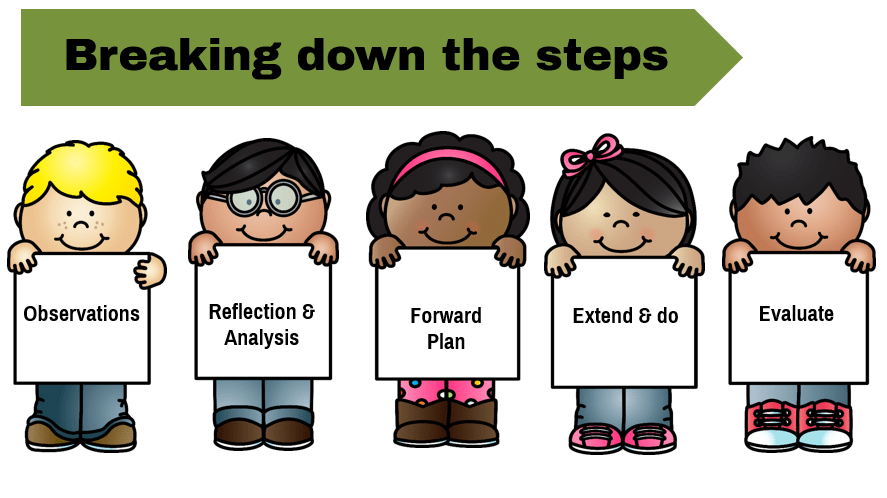
- Write down all the forms,templates, portfolios, journals, diaries, notepads, files, folders, apps, books, computer work you do and beside those write what they show evidence of.
- Now on a new page write down the basic steps of the planning cycle – read this previous post if you need help with identifying and understanding what is required for each step.
- Beside each step match one (or more) of the forms of documentation or evidence you identified on your first sheet of paper.
- Do you cover all steps? Are you compiling information for one step but not another?
- Do you understand how they all tie together and flow onto the next step?
- Do you have waaay to much paperwork and different recording methods for one of the steps but not others?
Now that you have a clear picture in front of you that should show exactly what you are recording, how you are doing it and why, it's time to think about how you actually use this information to plan your program and environment and if you can turn it into an organised system with a few regular and simple steps to follow each day. week, month to ensure you aren't wasting valuable time!
All of this ‘evidence’ you have been collecting isn't just because you need to have something in a folder – it needs to come together to show an ongoing cycle of planning, reflection and evaluation. We are required to use this information that we have been regularly recording to now ‘sum up’ a child’s progress or ‘distance travelled’ over time.
If you need some help identifying how you could break up tasks into daily/weekly and monthly steps you will find my FREE Mini Organiser Tool helpful.
It contains 3 checklists you can use to help you start forming your own system and develop a rhythm that works best for you. Tell me where to send your copy in the box below…
Organising Educator Paperwork – Developing a system that saves time.
To keep this action step very simple, think in terms of putting a jigsaw puzzle together. You want to put in place a clear system that brings together all the individual observations, analysis and extensions you have already recorded to build a picture of a child’s progress over time in care and complete the jigsaw puzzle.
It might identify gaps, celebrate strengths and interests, indicate a requirement for early intervention, explain to parents how their child is learning and progressing and help educators to put new goals in place and think about how they can help the child to work towards those goals.
Also…you want all that bloomin paperwork and documentation you are doing to actually be useful and not just a waste of your time because you were told to do it 😉
So to extend on the jigsaw analogy think of those linking ring type puzzles or making paper chains with children. A documentation system is basically a chain of evidence and all of the links (forms, templates, photos etc) come together to complete an overall picture. It can also include the changes you make to your environment, family communication, notes for improvements or changes you want to make, professional development, displays and events.
I created the infographic below to hopefully give you a visual of how creating a system where each preceding step leads to the next step and ultimately saves you time while still ensuring you meet all requirements. Knowing what you are doing and most importantly why, can be very valuable when working on time management and simplifying processes no matter what role you currently have.
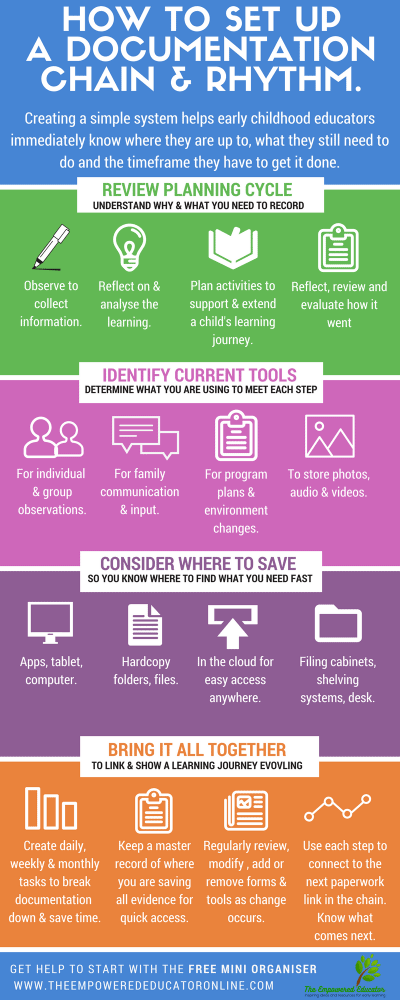
The scenarios below might also help you better grasp the significance of the chain I am describing and how it can quickly become time consuming if you don't have a system and rhythm already in place to fall back on!
- You snap some photos of the group at play outdoors- you noticed a couple of things you want to follow up on or an interest you want to encourage in next week's plan.
- You write a couple of quick learning stories on individual children at rest time while cleaning the toilets with the other hand.
- You notice the early morning shift educators have left some brief observations on post it notes or in a communication book for you – you will have to get to them later though as it's time for afternoon tea and the masses are already approaching with those scary hungry faces!
- You try to fill in a daily journal, phone app or load up the tablet with photos ready to use as a communication tool with parents and carers at the sign out table.
- You sit down to plan activities & environment setups for next weeks program but realise you need to find those forward planning notes you compiled from last weeks observations. And there was something you wrote down to remember in your daily reflections but where did you leave that again?
- You made notes about some resources and toys you need to put away or rotate due to some changes in developmental stages and abilities but can't find your notepad so will just leave it until next week and get something out then.
- And you need to talk to a parent about a concern they raised during the week concerning their child's development but it's been a huge week and you cannot remember what it was or where you recorded the parent input.
You get the idea…I may have exaggerated a little but for many educators this is often the reality. And that is where the frustration and overwhelm begins to take over.
But if you follow the action steps in this article you will be well on your way to finding a rhythm that works for you – put a little extra effort in now whether you work on your own or as part of a team and I promise it will save you time as the year progresses!
I strongly suggest (I'm being nice there…just do it!) that you narrow down where you keep all of your different documentation methods and systems. In action step 1 above you identified where they all are – now it's time to cull and collect a little…..yes even those post it notes you have everywhere.
Why? Because you waste time you don't have just looking for the stuff you need to complete the next lot of paperwork you are trying to get on with and it becomes a frustrating little cycle!
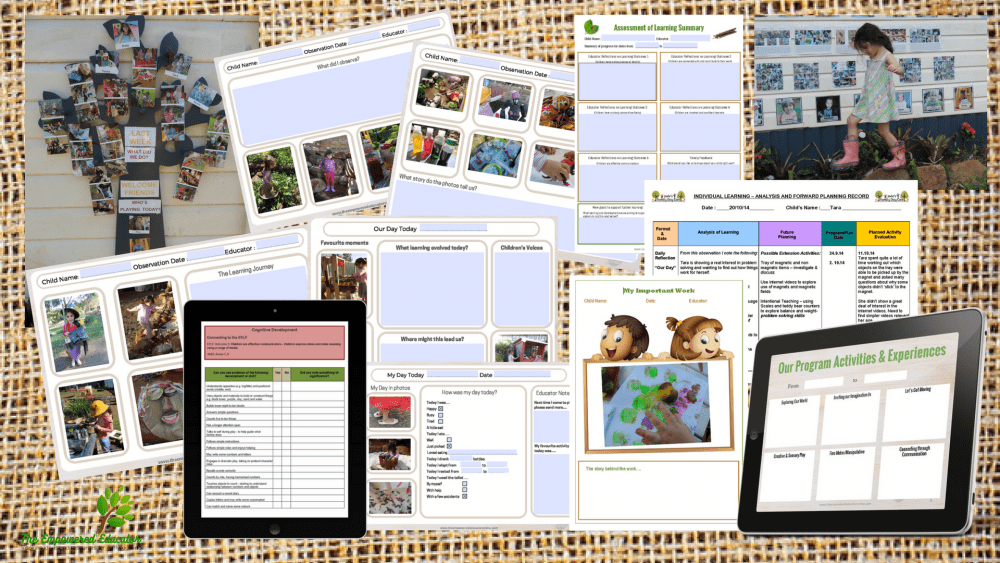
But let's stop talking about it and help you make it happen! I find it helps educators to get organised (rather than overwhelmed) if you break down the ‘chain links' into regular daily, weekly and monthly tasks.
First make sure you use the information you collected in the previous action step to help you start dividing up your documentation methods and where you currently store them all.
Do you know what you want or need to tick off each day, week or month?
When you know what you need to get done to make the next step simpler and bring everything full circle you stop wasting time and telling everyone that there is no way you can get it all done before end of the month! Paperwork and documentation is part of an early childhood educators role so let's just get on with it and put some easy strategies in place to make sure it's not only useful to the children but doesn't have you feeling like you need to be at your desk every weekend.
There really is no need for this – but you need a system and then you need to tweak it a little until you find it works well for you or for the room or entire team.
I know from emails I receive that many educators are still unsure about how to actually do this and still show those who need to know how you have been using everything to encourage and extend a child's learning journey over the time they have been with you. It's all about the chain and taking small but regular steps each day, week and month so you aren't trying to do everything all of the time!
If you are looking for an entire system already put together for you including calendars, daily diary, parent communication tools, forward planning and programming templates, sections with paperwork required already divided into daily/weekly/monthly sections and a whole lot more to help you get organised you need my Educator Organiser & Planner for Educators.
This is a useful tool created by a fellow educator who has been in your shoes and understands you need simple to use and effective tools not just waffle and pretty pictures.

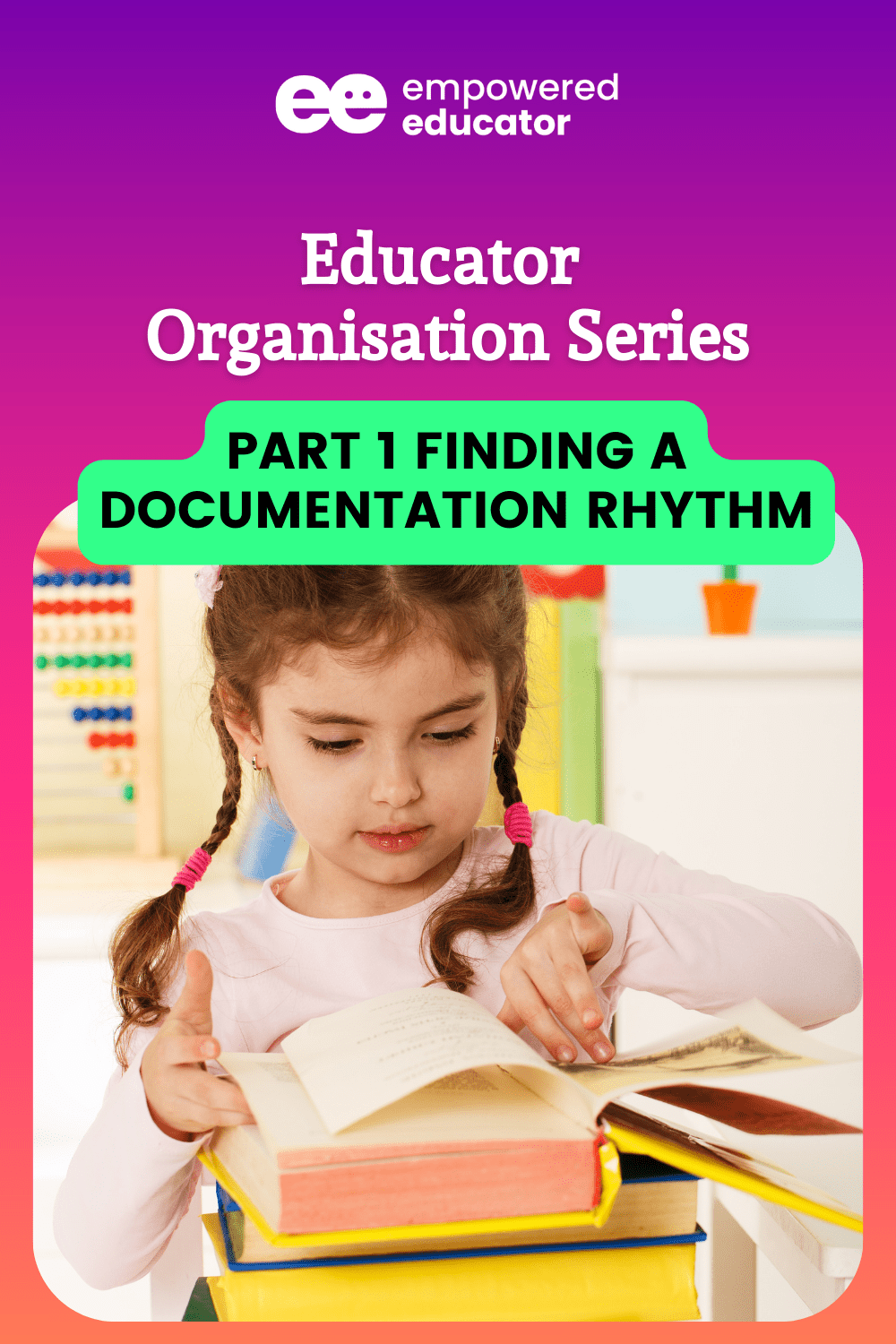
Get access to the Organiser included as part of your membership in The Academy For Empowered Educators along with all the templates, programs and training you need to simplify your planning and feel more confident as an early childhood professional!
The 4 Pillar Keep It Simple Approach To Planning is incorporated into all of the resources, training and templates throughout The Academy For Empowered Educators to ensure early childhood educators can spend more time engaging & extending learning with the children and less time documenting.
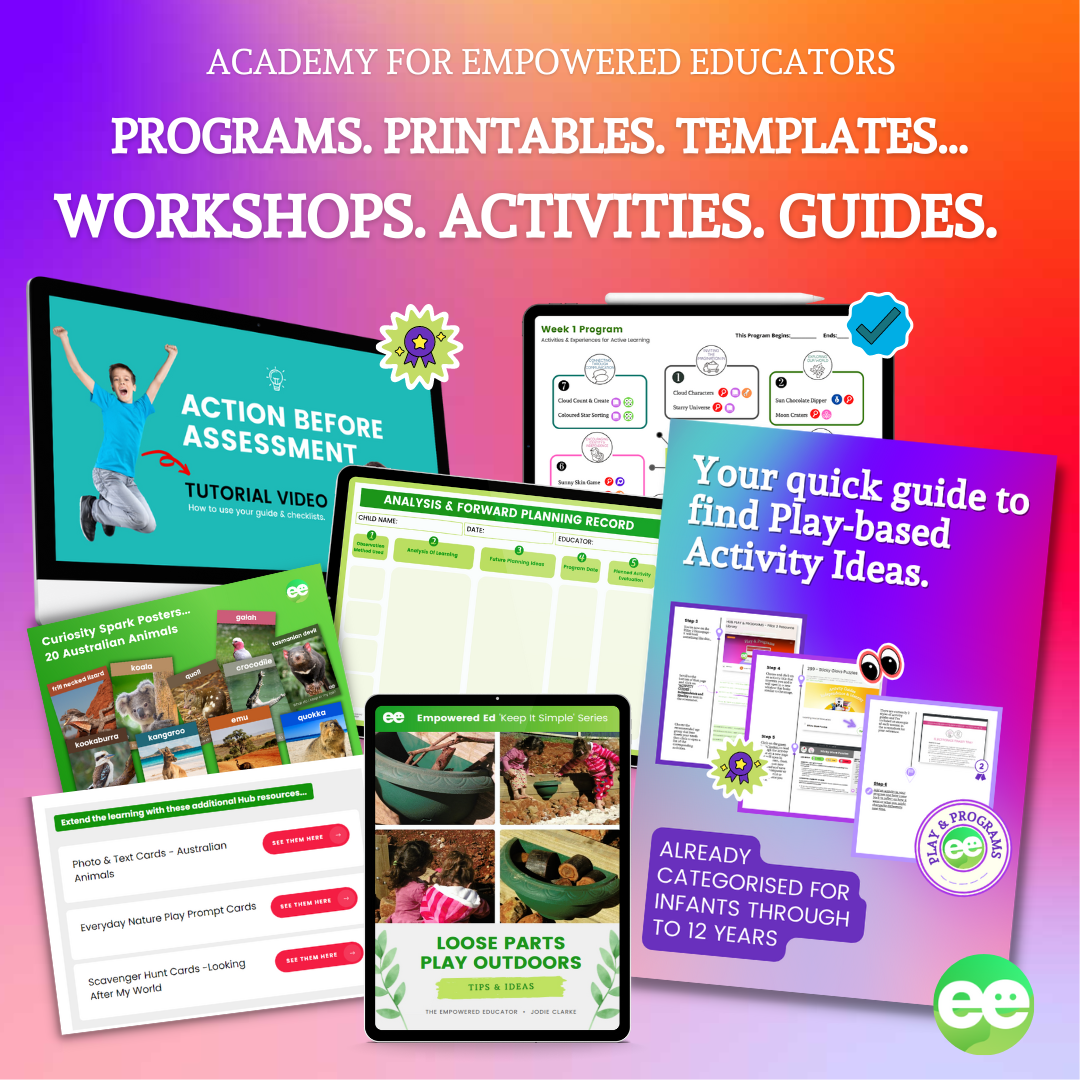

Hi Jodie learning stories are hard. Writting is hard. For family day care lots of paper work. Different age group planning is difficult. Any suggestions please. Thank you.